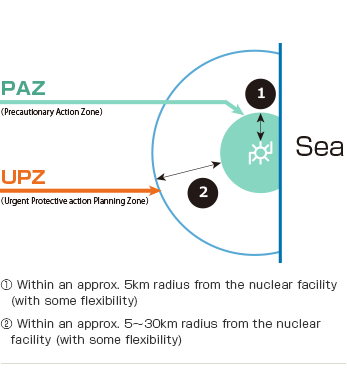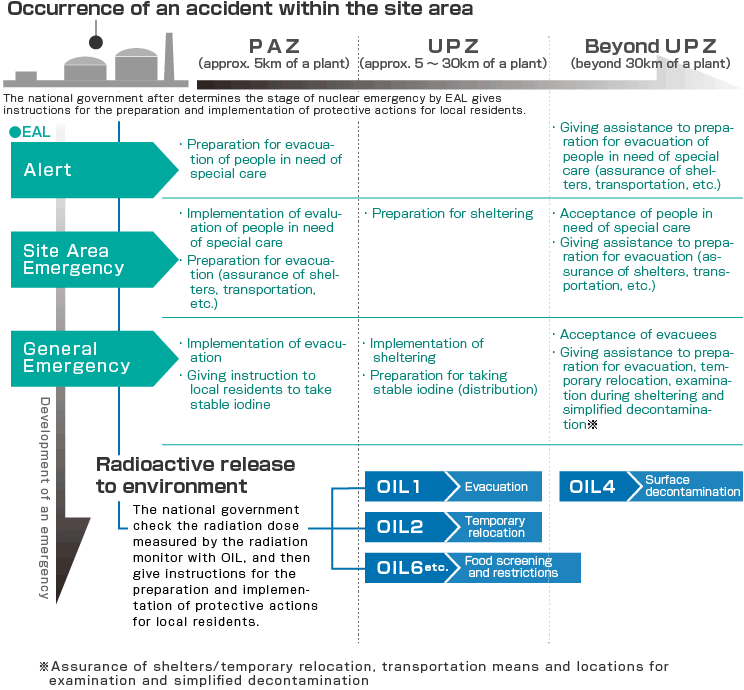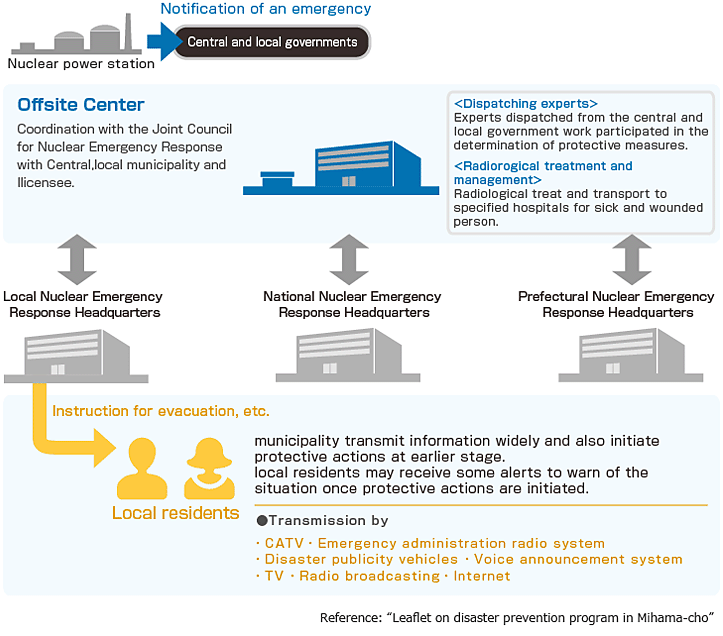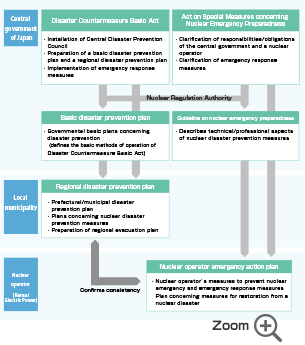Nuclear Power Information
Measures against Potential Natural Disasters
 Nuclear Emergency Preparedness and response plan
Nuclear Emergency Preparedness and response plan
Nuclear emergency preparedness and response of licenses in Japan have been taken continuously all out efforts against nuclear emergency for further enhancing nuclear safety coordinating with the central and local government formulated on the bases of relevant acts such Basic Act on Disaster Control Measures and Act on Special Measures Concerning.
Off site emergency zones and distances
To ensure effective protective actions and other responses can be promptly implemented to protect public, off site emergency zones and distances around the nuclear facilities are identified in advance during the preparedness stages referred to the guideline on nuclear emergency preparedness.
- <PAZ(Precautionary Action Zone)>
- An approx. 5km radius area from a nuclear facility for initiation of provisional protective actions before the start of a release warranting protective actions off the site depend on Emergency Action Level (EAL, nuclear facility condition) in order to prevent and mitigate stochastic effect.
- <UPZ(Urgent Protective action Planning Zone)>
- An approx. 5to30km radius area from a nuclear facility for initiation of urgent protective actions such distributing KI tablets and shelter in peace before or shortly after the start of a release of radioactive material warranting protective actions off the site depend on EAL and Operation Intervention Level(OIL, air radiation dose or contamination, etc.)

(Note) The actual boundary of the zones for which protective actions, including evacuation, sheltering and stable iodine prophylaxis, are implemented based on the EAL and OIL does not necessarily form a circle.
Reference: Guideline on Nuclear Emergency Prevention Measures (established by Nuclear Regulation Authority on October 31, 2012)
UPZ Municipalities
| Fukui | Kyoto | Shiga | Gifu | |
|---|---|---|---|---|
| Mihama Power Station | -Mihama-cho -Tsuruga city -Wakasa-cho -Minamiechizen-cho -Echizen-cho -Obama city -Echizen city |
-Takashima city -Nagahama city |
-Ibigawa-cho | |
| Takahama Power Station | -Takahama-cho -Ohi-cho -Obama city -Wakasa-cho |
-Maizuru city -Ayabe city -Nantan city -Kyotanba-cho -Miyazu city -Ine-cho -Fukuchiyama city |
-Takashima city | |
| Ohi Power Station | -Ohi-cho -Obama city -Takahama-cho -Wakasa-cho -Mihama-cho |
-Kyoto city -Maizuru city -Ayabe city -Nantan city -Kyotanba-cho |
-Takashima city |
Protective actions based on EAL and OIL
A basis for taking protective actions to reduce and mitigate radiation exposure of local residents and workers has been established in advance so that judgment and instructions for protective actions can be made immediately.
Specific protective actions will be judged to implement by the Nuclear Regulation Authority according to the situation and instructions will be given by the National Nuclear Emergency Response Headquarters.
| Emergency Action Level (EAL) |
EAL detemined by plant parameters in each plants and other cirmcumstances is used for declaration of emergency classification as AL,SE and GE for the initiations of public protective actions. |
|---|---|
| Operational Intervention Level (OIL) |
An OIL is used immediately and directly (without further assessment) to determine the appropriate protective actions on the basis of an environmental measurement. OILs are typically expressed in terms of dose rates or of activity of radioactive material released, time integrated air concentration, ground or surface concentration or activity concentrations of radionuclides in environmental food or water samples. |

| Emergency classification and EAL example | |
|---|---|
| Alert |
|
| Site Area Emergency |
|
| General Emergency |
|
| OIL description | ||
|---|---|---|
| OIL1 | Criteria for evacuation | Execute evacuation by designating the evacuation area within a few hours |
| OIL4 | Criteria for surface decontamination | Provide screening of evacuees and decontamination for those exceeding the criteria |
| OIL2 | Criteria for temporary relocation | Designate the evacuation area in about a day and perform temporary relocation within a week |
| Food and water screening criteria | Criteria specific to the area measuring radionuclide concentrations of food and water samples | Designate the area that measures radionuclide concentrations of food and drink within a few days Measure radionuclide concentrations in food and water samples within a week and provide ingestion limits on those exceeding the criteria |
| OIL6 | Criteria for ingestion limits | |
Reference: Guideline on Nuclear Prevention
Communication scheme in Nuclear Emergency
In the event of nuclear emergency, a licensee immediately notifies it to the central and local governments. The representatives from the central government, relevant prefectures, municipalities and licensee joint together at the Off-site Center and discuss to determine the protective measures according to information exchange and situations. The decisions made at the Off-site Center will be transmitted to local residents through the Nuclear Emergency Response Headquarters operated by individual municipalities.






